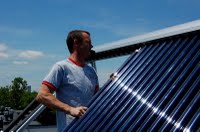One of the first home improvements Rachel and I made when we purchased our condo here in Cambridge this spring was a solar hot water installation on our rooftop.
The system we had put in uses vacuum tubes, a newer, more efficient type of solar collector than the black box flat panels of old. As a writer covering energy and the environment in Cambridge and China, I’d spent the past three years tracing this new and exotic technology back to the factories and cities in China where they are surprisingly commonplace.
I first read about the tubes three years ago in a story in the Boston Globe. A family in Newbury, MA was using a massive installation to provide hot water and heat for their giant barn of a house. A photo that went with the story showed their installation covered in frost on a cold winter day. Somehow, despite the cold, the tubes were still kicking out 120 to 160 degree water.
 The secret behind vacuum tubes that allows them to work just as well in winter as summer is, just as their name suggests, a vacuum space. The diagram at the right shows how the tubes work. Sunlight passes through a clear outer glass tube and travels through an evacuated space or vacuum where all of the air has been sucked out. The sunlight passes through this vacuum and then hits an inner black pipe that absorbs the sun’s rays converting the sunlight to heat. What’s key about all of this is that whereas light rays can pass through a vacuum space, heat can not. All of the heat is therefore trapped inside by this highly efficient, transparent insulator.
The secret behind vacuum tubes that allows them to work just as well in winter as summer is, just as their name suggests, a vacuum space. The diagram at the right shows how the tubes work. Sunlight passes through a clear outer glass tube and travels through an evacuated space or vacuum where all of the air has been sucked out. The sunlight passes through this vacuum and then hits an inner black pipe that absorbs the sun’s rays converting the sunlight to heat. What’s key about all of this is that whereas light rays can pass through a vacuum space, heat can not. All of the heat is therefore trapped inside by this highly efficient, transparent insulator.

After I read the story in the Globe I found out that there are thousands of factories kicking out these tubes in China and roughly 1 in 10 Chinese people use them for their hot water.
Six months after first hearing of the tubes, I toured the R&D center of one of these factories in Beijing for a story I wrote for New Scientist.
The story also led me to Rizhao, a city on the coast between Beijing and Shanghai where 99 percent of residents get their hot water from the sun. Here is a video I made from a rooftop of the city while talking with Rizhao’s mayor, Li Zhaoqian.
By the time we had a chance to buy a place of our own I was totally sold on the technology and couldn’t wait to put the tubes in on our own place. Evacuated tubes are still hard to come by in the US, however, and most of the installers I spoke with insisted they were no better than the flat panel solar collectors that had been around since the 70s. The estimates I got for flat panel installations, however, were twice the size of what I figured I could get by with using vacuum tubes. Then I found Bruce, a contractor with New England Solar Hot Water, who, like his company’s name suggests, only does solar hot water installations. Bruce and his crew had been doing vacuum tube installs for years and were stoked to hear I’d actually toured some of the factories where they get their parts.

In mid June they installed the collectors shown on the right that heat all of our domestic hot water; the water we use for showers, laundry, and in our sinks. The system is backed up by natural gas but on a sunny day like today, its unlikely we’ll need it. At 9am, with an outside temp of 43 F, our tubes are already a toasty 95 F and climbing.


Speaking of solar, NOVA is recycling an old episode this month “Saved by the Sun.” It’s viewable online, or on air.
Pingback: Making Your Home Solar Powered |